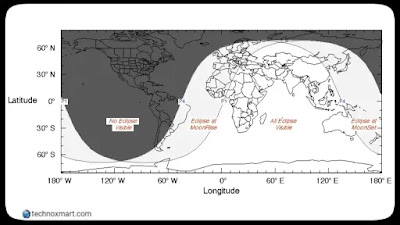June 2020 Lunar Eclipse: Here's
How You Can Watch Penumbral Lunar Eclipse Live, Know Timings In India On June 5
& More Here
A penumbral
lunar eclipse can also be confused with a full moon, but this time the full
moon and the eclipse coincide.
There
is practically another lunar obscuration or Chandra Grahan, and this year it's
fourth. It will be obvious from India, and a few pieces of the world. This
overshadowing will be an incomplete penumbral obscuration meaning the Moon will
travel through the black out, external piece of Earth's shadow called the
obscuration. This kind of penumbral overshadowing is frequently confused with
an ordinary full Moon. Along these lines, it is likewise being alluded to by
name including Strawberry Moon Eclipse, Mead Moon Eclipse, Honey Moon Eclipse and
then some.
ALSO SEE
|
Lunar
Eclipse June 2020: Check Next Lunar Eclipse Timings, Date & More In India
|
Lunar
Eclipse 2020: Check Date & Timing On 10 January
|
Penumbral Lunar Overshadowing 2020: What Right?
A
penumbral lunar overshadowing is one of the three sorts of lunar obscurations -
aggregate, halfway, and penumbral. During a penumbral lunar overshadowing, the
Earth hinders a portion of the Sun's light from straightforwardly arriving at
the Moon and the external piece of the Earth's shadow, called the
'obscuration', covers all or part of the Moon. Since the obscuration is fainter
contrasted with the dull center of the Earth's shadow called 'umbra', this
shroud is more earnestly to spot. This is likewise why now and again a
penumbral lunar obscuration is mixed up as a full Moon.
June Full Moon Or Strawberry Moon
On
5-6 June, the full moon of June will compete with the penumbral lunar shroud,
and the full moon will occur,
according to Space.com, at IST 12:42 am on 6 June. It will be obvious from
India and different pieces of the world, in any case, North America and the
majority of South America will pass up it. Strawberry Moon is a moniker for a
full moon that shows up in June. It name from the strawberry collecting season
in some piece of the US.
"Maine
Farmer's Almanac distributed 'Indian' names for the full Moon in the 1930's. As
indicated by this Almanac, as the full Moon in June and the last full Moon of
spring, the Algonquin clans called this the Strawberry Moon. The name
originates from the generally short season for reaping strawberries in the
north-eastern United States," composes NASA.
ALSO SEE
|
Know
About June 2020 Strawberry Moon: Here Is Timings, Dates, Live Details &
More
|
Lunar Eclipse 2020: 9 Smartphone
Camera Tips To Take It
|
When And Where To Watch The June 2020 Lunar Shroud
The
penumbral lunar overshadowing will begin at 11:15pm on June 5 and keep going
until 2:34am on June 6, which is around three hours and 18 minutes. It will be
noticeable from Eastern Africa, the Middle East, Southern Asia including India,
and Australia. According to the information by NASA, the overshadowing will be
obvious to individuals living in the Eastern shoreline of Western Africa, South
America, and Europe at Moonrise and to individuals in Japan and New Zealand at
Moonset.
The Most Effective Method To Watch The Penumbral Lunar Obscuration
The
penumbral lunar overshadowing might be difficult to spot however well known
YouTube stations including Slooh and Virtual Telescope are known to have
livestreams. Virtual Telescope Project 2.0 is additionally supposed to convey a
live webcast of the obscuration that will be facilitated by cosmologist
Gianluca Masi.
Three Obscuration In A Lunar Month
The
lunar obscuration on June 5 is the first of three lunar shrouds in this lunar
month of June to July 2020, according to a report by EarthSky. This is likewise
called overshadow season. The first, as we know, is a solar eclipse visible
from Africa, South East Europe and Asia on June 5 and followed by June 21. The
last lunar shroud will occur on July 5 which will be noticeable to individuals
in North and South America.
For Regular & Fastest Tech News and Reviews, Follow TECHNOXMART on Twitter, Facebook, Instagram, Google News and Subscribe Here Now. By Subscribing You Will Get Our Daily Digest Headlines Every Morning Directly In Your Email Inbox. 【Join Our Whatsapp Group Here】














No comments:
Post a Comment